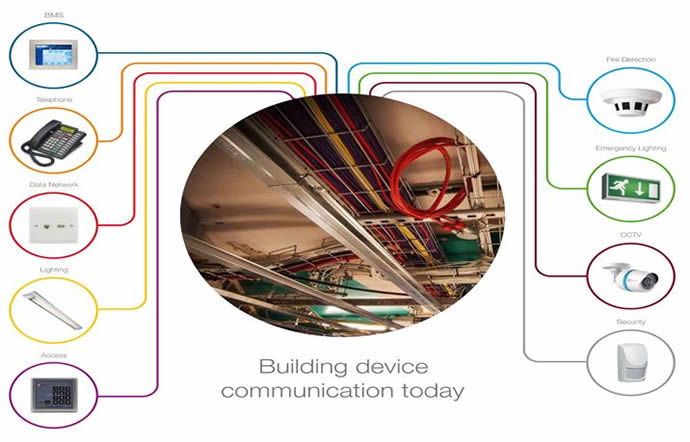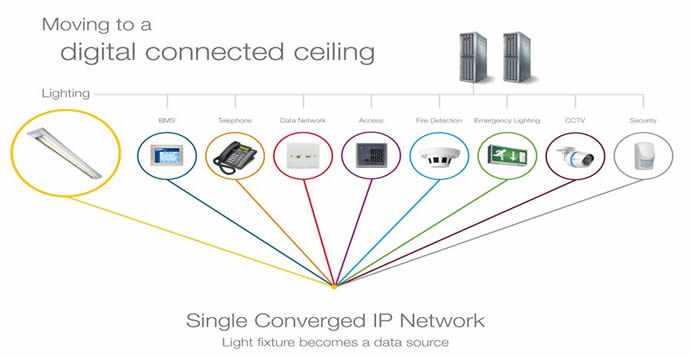Lighting and the IoT go hand-in hand into a connected future
Lighting specialist Tridonic celebrated its 50th birthday earlier this year at the company’s National Partner Conference, and a key part of the celebrations was to highlight what Tridonic believe will be the most exciting advancement in connected lighting seen in the industry.
The lighting industry has transitioned towards LED technology in recent years and that shift has occurred at such a pace that LEDs are now viewed as a commodity, with the market now nearing saturation.
Simon Blazey, Strategic Solution Sales Manager at Tridonic, commented: “The event was used to highlight lighting and the IoT. We’ve gone from conventional lighting to LEDs, to the extent where LEDs are very much the norm and people are now starting to ask, what else can lighting do?”
Attendees at the event were invited into Tridonic’s Lighting & Beyond theatre where Blazey explained that in years gone by, when designers and developers wanted integration and interoperability of building systems, they have been hampered by silo systems, protocols and gateways.
Blazey added that to achieve a single converged IP network in the future then lighting will play a key part. Speaking to Electronic Specifier Blazey commented: “One of the major things an IoT sensor needs regardless of the application is a low powered wireless network. The power of lighting has come down so fast that it can now be powered over the internet to the point that you could place wireless access points within the luminaire and plug them into the IP infrastructure and provide a wireless network and access through the lighting.
“What that means is that luminaires can be plugged into an Ethernet switch and a wireless access point can be plugged into the ports of that switch, and those two devices can coexist on the same infrastructure. So once you go onto an IP connected lighting solution you have an infrastructure that is essentially IoT ready because you have an opportunity to plug anything into that network that can coexist or cooperate. Because lighting is everywhere it fits very well with IoT requirements.
“IP connected lighting has been a race between us and our competitors for around the last two years. As the efficiency of lighting has gone up, so the opportunities in this area and the role lighting can play in the IoT has been obvious.”

For organisations that provide building systems solutions the IoT presents a massive opportunity as 40% of the IoT is expected to be in commercial buildings. There is a great deal of synergy between lighting and the IoT, as they will both ubiquitous. One of the major challenges of the IoT will be the requirement for low power, wireless networks and lighting can help to meet this.
When lighting is the IP infrastructure it allows constrained IoT devices to reach their service application through the lighting. Tridonic’s net4more is an IPv6 solution that provides a toolkit for luminaire manufacturers to customise their luminaire and embrace IP and IoT technology.
Speaking at the conference, John Swallow, Director of Energy Efficiency at GMI Energy said: “It is clear that LED lighting can provide better control and operational savings against conventional lighting, however, GMI Energy wanted to embrace the potential of IP connected lighting and establish if it could be cost neutral.
“The outcome from a costing exercise carried out by GMI Energy demonstrated that IP connected lighting provides a reduction in installation costs and time before you even consider the business value that can be leveraged from an IoT ready installation.”
From the perspective of the end user, Iain Trent, Engineering Director at Land Securities added: “We have been a pathfinder for integrated and intelligent buildings since the early 1990s. IP connectivity eliminates the need for gateways and through installing IP connected lighting in our new head office, we recognise it can incubate ideas, analyse data and truly understand how tenants will demand and use office space in the future.”
Asked whether lighting will be the ultimate driving force behind the IoT, Blazey continued: “In the building environment I think lighting will be the catalyst for the IoT. If you think of retailers, they place huge demands on data and when you think of the ubiquitous nature of lighting, that has huge benefits in terms of data for building owners, operators and end users. The role that lighting will play will take it beyond pure illumination itself and provide a platform for business data and business efficiency.
“In the short term retailers stand to benefit the most as they are data hungry, more so than anyone else. The other area of initial benefit will be in the commercial environment in terms of office space where developers want to attract occupants of the future. The other early adopters will be universities, the main reason being that their own infrastructure could be very much part of their curriculum and studies. Some university courses include the development of apps and the development of technologies, so they need an IT infrastructure.
“IP connected lighting also has a role to play in smart cities of the future. It can be scaled right the way up. Smart cities will need IP lighting to realise their full potential and they will need to adapt to a changing environment, for example, being able to reduce lighting in areas that don't need it in order to lower energy consumption. In Lyon, France, their traffic infrastructure is controlled through their outside lighting - they can change the flow of traffic as the outside lighting sensors pick up traffic levels and avoid congestion by redirecting traffic flow.”











